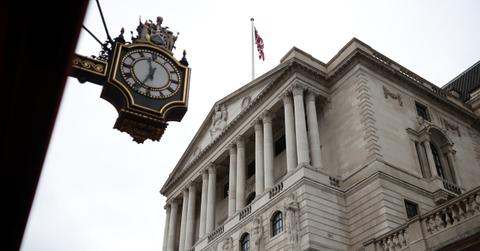What the Collapse of the British Pound Would Mean for You
The British pound is losing value — rapidly. It’s reminding us of the 1992 collapse, dubbed Black Wednesday. Here's what we know about the pivotal moment.
Sept. 26 2022, Published 12:57 p.m. ET

The British pound is losing value — rapidly. It reached a record low against the dollar on Sept. 26, briefly nearing parity. The downtrend is reminiscent of the 1992 pound collapse, dubbed Black Wednesday.
Black Wednesday marked a pivotal moment in the United Kingdom by suggesting it was economically feasible to operate outside of the Eurozone in the modern day.
As the pound loses value at a fast pace again, the U.K. may face a reckoning again.
What happened in the 1992 British pound collapse?
On September 16, 1992, the U.K. withdrew the pound sterling from the European Exchange Rate Mechanism (ERM). At the time, the U.K. was a part of the EU.
Prior to the withdrawal, American-Hungarian businessman George Soros shorted the pound and convinced a large swath of others to do the same.
Business owners and consumers began to believe the sentiment, resulting in increased pressure on the pound. Soros is credited with “breaking the bank of England” while making off with a $1 billion profit amid the sell-off of the pound.
The British pound collapse of 1992 wasn't the be-all-end-all of the U.K. economy. In fact, the economic landscape gained momentum and, by the mid-1990s, was by all means thriving. By dipping into the reserves and retaining the pound, the U.K. stayed out of the Eurozone and was able to have control over its monetary policy.
So, why is the pound down in 2022 — and will it recover?
The British pound lost nearly 4 percent of its value from Thursday, Sept. 22 to Monday, Sept. 26. On the latter date, the pound is just eight cents above parity with the U.S. dollar.
The pound briefly fell below $1.08 before regaining some value, but that still marked its lowest point since September 2020. The record low of $1.03 is below the previous record low of $1.05, reached in February 1985.
Some things are different now than they were in 1992. For example, the U.K. is no longer a part of the EU, meaning it doesn't have the safety net of the Eurozone. Plus, it has independent control over its policy. For some, that’s a problem.
Senior market analyst at Oanda, Craig Erlam, said, "Serious questions are already being asked about the economic competency of the new government.”
Erlam added these questions are intense enough “that markets are factoring in a strong chance of a substantial emergency rate hike from the Bank of England in order to shore up the currency and confidence in the markets."
While the U.S. dollar gains ground, the U.K. pound moves in the opposite direction. What’s the difference? For one, the U.K. has the highest inflation rate of all the G7 nations, despite the fact it has managed to maintain a relatively moderate level of inflation in previous new-millenium decades.
This suggests the government may be on unstable footing, giving people less reason to retain confidence in current and future decisions.

These decisions are crucial on whether the pound will recover. As the U.K. government attempts to restore value against the dollar, interest rates are poised to rise (by a lot) and other uncomfortable economic policies will likely come into focus.

